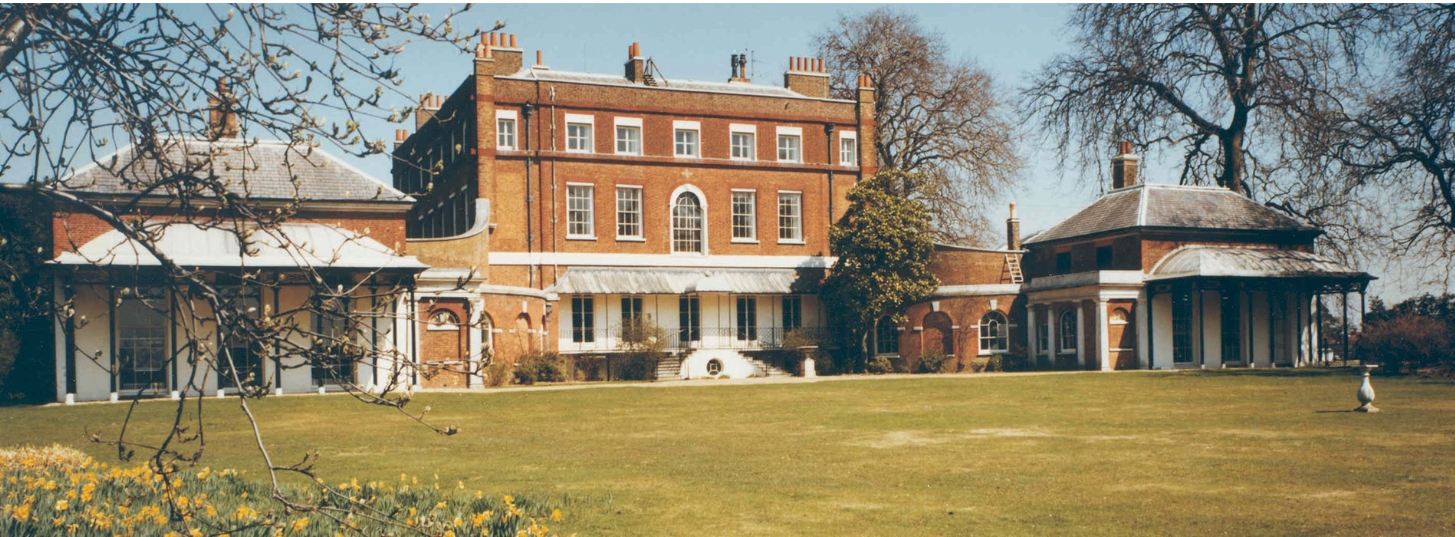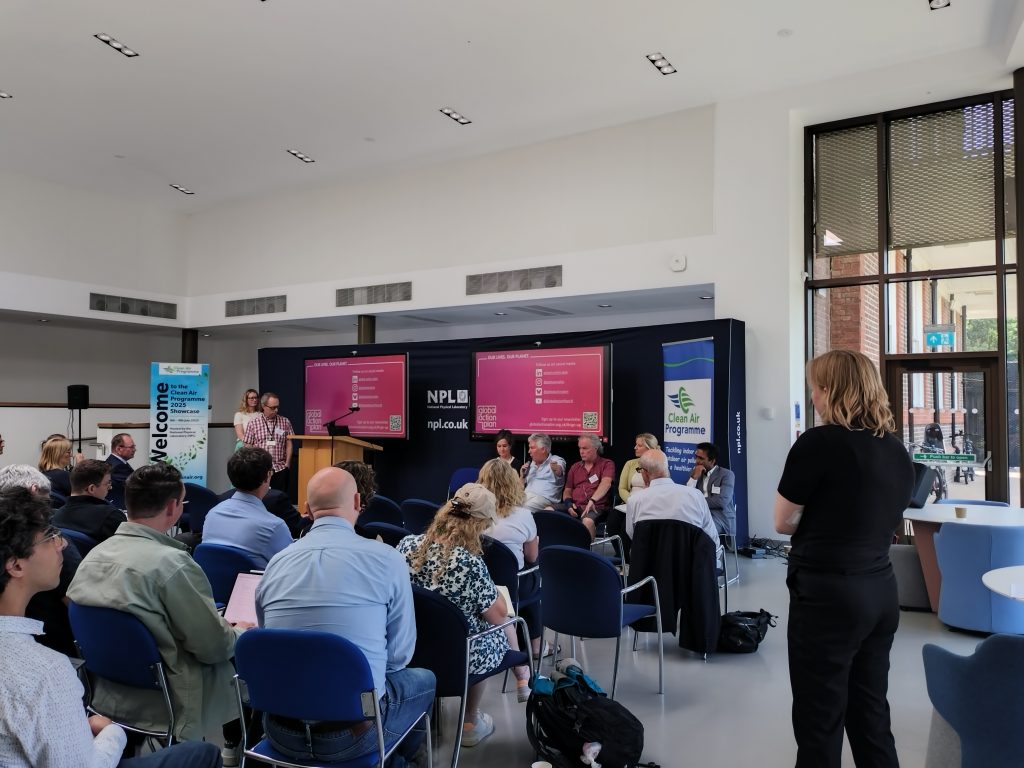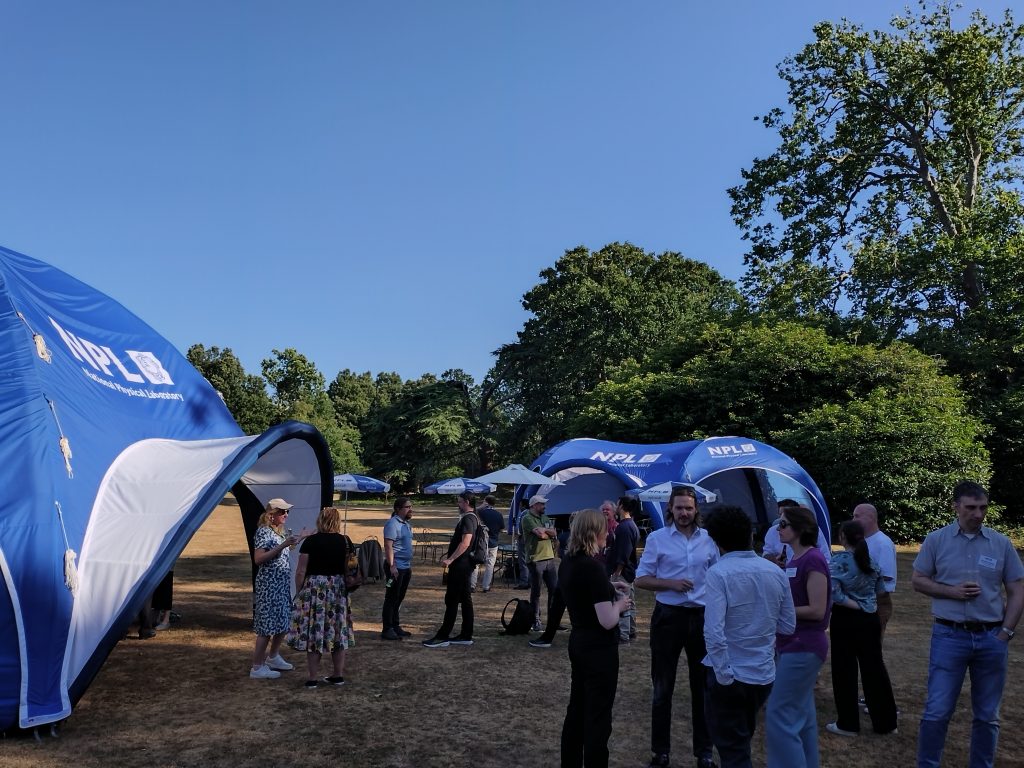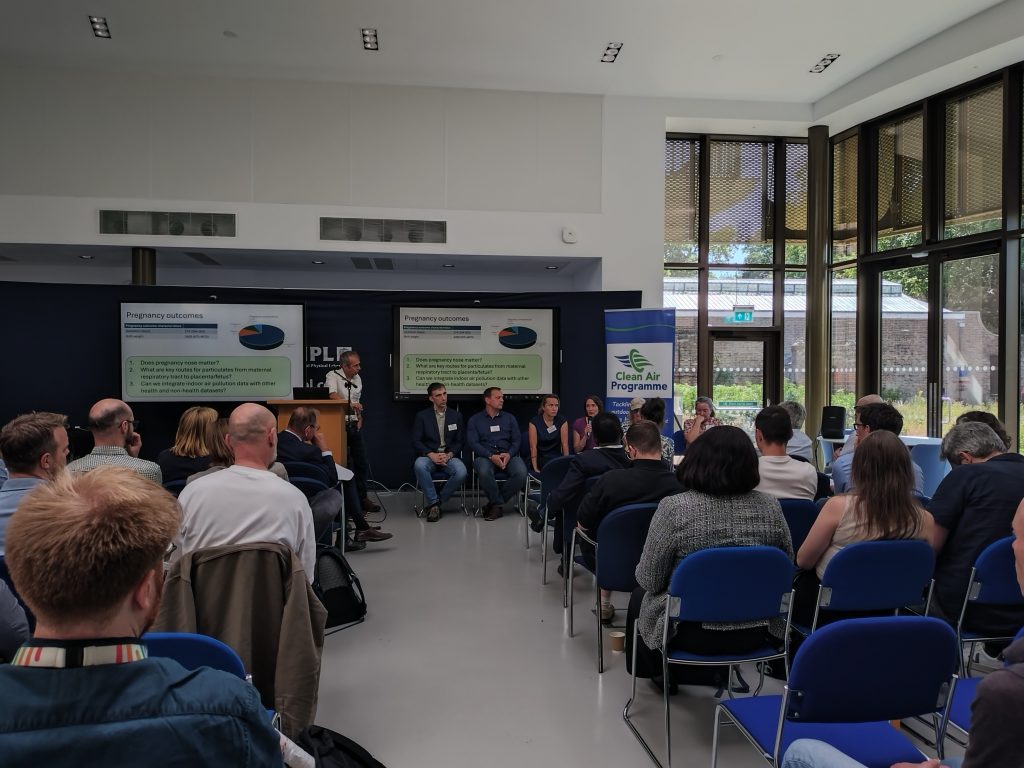
Prof Sir Stephen Holgate
National Physical Laboratory, Teddington 8th– 9th July 2025
On July 8th and 9th, the UKRI Clean Air Programme came together to showcase the achievements of the Clean Air Strategic Priorty Fund (SPF) and to explore possible future directions for research in this field. The event was held at the splendid and historical Bushy House (a Grade II listed former residence of King William IV and Queen Adelaide) and the adjacent Institute for Quantum Standards and Technology at the National Physical Laboratory in Teddington. This was a most fitting location for our last annual meeting of the Clean Air SPF with the stated purpose of the institute in Fostering collaboration between far-reaching scientific areas, aptly describing the interdisciplinary science that has been the driving feature of this SPF programme over its six years or so of funding. It also hosts the cutting of Newton’s apple tree reminding us of the long history that air pollution has, and was the venue of our first meeting Joining Forces of the Clean Air SPF held in October 2020.
A highly productive interactive meeting organised by NERC and held in glorious weather meant that delegates could rapidly become appraised of the Clean Air SPF and the exciting research it is delivering. While the event coincides with the completion of many of the projects and programmes supported by the UKRI and Met Office in close partnership, several are just reaching their final stage or are still ongoing in the form of the four large consortia.

After welcomes on the first day, the Clean Air Champions, Stephen Holgate, Gary Fuller and Suzanne Bartington, gave overviews of this unique programme and its two waves of research activity, wave 1 on gaps in current air pollution knowledge and wave 2 on emerging pollution issues. We then opened with more in-depth exposure to the large multidisciplinary research networks and consortia BioAirNet, HIP-Tox, TRANSITION, WellHome, and the Met Office Engaging the Public project undertaken by Global Action Plan followed by an interactive Q&A session.
On Day 2 the morning session enabled further coverage of the Wave 2 activities Breathing City, HEICCAM, INGENIOUS, Clean Air4V, TAPAS and RESPIRE with another highly interactive Q&A Panel to follow. Taken together, these presentations with their cross-cutting activities engaging many different sectors, provided ample proof that a unique Clean Air Community had formed with a strong focus on interdisciplinarity and practical applications. Much of the discussion was directed to learnings from the research and how the outcomes could be utilised by stakeholders.
The afternoon of day 1 provided an opportunity to gain input from the Showcase attendees in a series of workshops dealing with the future. During these well-structured small group sessions, delegates were asked to provide their ideas on what additional research and development could be required and utilised to deliver continued improvement in the breathed environment. The outcome of these highly productive small group sessions is being compiled and will be synthesised into an accessible document as well as into an Impact Report that the Clean Air Champions are currently developing with the research community.
As part of the workshop session, Kieran Laxon (Vice-Chair of the Institute of Air Quality Management [IAQM]) presented a forward-looking vision that has been evolving with the Clean Air Champions and Met Office for creating a sustainable Community for Clean Air with the IAQM and the Institution of Environmental Sciences (IES) providing the support and infrastructure, with the new body being run by a dedicated cross-disciplinary Steering Group. Kieran indicated that this would require some fund-raising for the first 18 months with a plan to launch a multi-stakeholder Clean Air Conference in 2026; thereafter it would be self-supporting. Any suggestions and input into this idea were welcomed since many agreed that, after six years of successfully working together across the UK, the UKRI/SPF investment should aim to have a sustainable long-term legacy to continue its work in helping create cleaner and healthier air.
After a stimulating day, we retired to a most convivial and memorable BBQ hosted by the NPL and held in the beautiful grounds of Bushy House. After a long day, this was a very welcome event, and we were all so impressed by the kindness displayed by all the NPL staff who helped make this a wonderful occasion.
On the second day, we heard from Kevin O’Malley (Innovation Lead in the Urban Systems Team at Innovate-UK) about Innovate-UK’s Wave 2 awards in supporting the development of cutting-edge technology to tackle air pollution with a focus on indoor air. Kevin described the process of how these projects were competitively selected and then, after a small initial investment and a second round of assessments, how those to receive full support for development were selected for development.

We then heard a synthesis of the Met Office Wave 2 projects from Noel Nelson who emphasised the added value that had been achieved by working with UKRI in the integrated Clean Air SPF. There can be no doubt that, as individuals, both Kevin and Noel have brought immeasurable practical opportunities to the Clean Air Programme to create its unique interdisciplinary and multidisciplinary research community.
There followed an Innovative Air Quality Solutions Exhibition at which examples of the Innovate UK Wave 2 Clean Air Tech sector were on display Personalised, Actionable Air Quality Monitoring for the Entire Family (Nooku); Smarter Home Indoor Air Quality Monitoring System (Aerlusive™); Harnessing Nanoparticle array technology for the removal of domestic atmospheric pollutants (CodiVent Air Filter and KluraLabs); Platform technology for the removal of critically underserved pollutants in homes (Immaterial) and Measure, Inform, Nudge: an integrated, human-centric air quality measurement & visualisation system (arbnco), along with some of the Network and Met Office projects including a demonstration of the Clean Air Portal. Some of these Innovate business developments had already reached the marketplace (e.g., Nooku indoor air quality monitor now available at Currys!). During this period, Tom Gardiner, Science Area Leader for Emissions and Atmospheric Metrology at NPL, our host and a strong supporter of the Clean Air Programme throughout, arranged tours of the NPL’s impressive laboratories. These proved not only popular, but a real eye opener on the amazing work the NPL does to support cleaner air. We were especially grateful to the NPL Research Staff who, not only explained some of their complex science in a highly understandable manner but were also prepared to effectively field the challenging questions of the visitors.
After an enjoyable lunch with the NPL Researchers, the afternoon began with an upbeat perspective of three of the recently announced Realising the health co-benefits of the transition to net zero Hubs being overseen by the MRC (Graham Campbell, MCMB and PSMB) for the UKRI and NIHR – The INHABIT Hub (The Indoor HABItability during the Transition to Net Zero Housing Hub), The CHILI Hub (Child And Adolescent Health Impacts Of Learning Indoor Environments Under Net Zero) and The HEARTH Hub (the National Research Hub on Net Zero, Health and Extreme Heat). It was gratifying to see that these had many participants from the Clean Air SPF Programme. With two inciteful overview talks on the NERC/DEFRA Supersites by James Allen and Upper-Air Overhead Measurements by Noel Nelson the scientific part of the meeting came to an end.
The whole event was rounded off by a fascinating perspective from Rupert Lewis, the Deputy Executive Chair of NERC, during which he gave us an insight into how the workings of government has changed during his long-time and many different posts in the civil service and with specific reference to environmental (and air quality) policy development.
After thanks by the UKRI, Met Office, NPL and the Clean Air Champions, we all left Teddington very much the wiser in the clear knowledge that this Clean Air Research Community must continue. We owe our thanks to Tom Gardiner for providing us with such a splendid location and wonderful support from NPL staff for this most enjoyable and informative conference. We owe special thanks to Natasha Soutar and Kay Heuser at NERC for their extraordinary dedication in assembling the Showcase programme who together ensured that our meeting was a great success. Sadly, we learnt that Natasha was unable to join us at the event due to illness and we all wish her well in her recovery.

While this will be the last annual conference for the Clean Air SPF Programme, it ended with an upbeat and forward-looking tone at the same venue as our inaugural event. We are hopeful that all those involved in the Programme since its inception in 2019 will wish to help by supporting the new Clean Air Community and, hopefully, a continuation of the Annual Conference involving a wider group of researchers and stakeholders. In the meantime, until the end of their extension to March 2026, the Clean Air Champions aim to deliver smaller workshop and roundtable events. These will be based around the outputs from the wave 2 research consortia: indoor air pollution and health, early life air pollution and health, Air Quality in the 21st Century (in conjunction with the Royal Society of Chemistry), later life air pollution and health, advances in urban air quality science and connecting air pollution, social science research and arts as an engaging way of conveying air pollution awareness and information. Please do express any interest in attending and or participating in any of these by contacting the Clean Air Team contact@ukcleanair.org.